DistroKid Review
Aug 13, 2023
You’ve written a few songs and are ready to release them into the world. Congratulations!
But how do you distribute your music to various streaming platforms, and which service should you use?
That's a great question and I'm happy to tell you I can help with this.
Over the next few blog posts, I plan to take a deep dive into some of the most popular digital distribution hubs and highlight the pros and cons of each platform.
Before we get into my choice for today, let’s talk a bit about digital distribution and why it’s necessary.
The Rise of Distribution Platforms
If you were releasing music before the advent of music streaming, you would use a distribution service to print and distribute your release.
(If you played in a band during this time and released your music independently, you most likely still have a box of CDs lying somewhere in your parent’s basement).
If you were signed to a major record label, they would take care of the distribution for you. But, as an independent artist, you would need to find a physical distributor to help you get your music into stores. Remember going to HMV at the local mall? This is exactly the distribution I'm talking about. There was no such things as online music. Everything was physical. You needed someone to distribute your music in the physical world, now that it's digital, it becomes a lot easier.
Once streaming became the norm for music consumption, it changed the game in distribution and caused digital distributors to rise and provide options for independent artists looking to share their releases. Think of these distributors as a “go-between” for independent artists, small labels, and streaming services like Apple Music or Spotify.
But, while these distributors have become more prevalent, they are not all created equal. Just as the music landscape is constantly changing, so are the options for music distribution.
In this blog series, I will share my takeaways on some of the most popular distribution platforms and even do a couple of comparison posts so you can know your options for sharing your music with the world. For example, I'm going to cover a full review of TuneCore and also a review of CD Baby. I'll also do comparison posts on TuneCore vs CD Baby, another TuneCore vs DistroKid, and DistroKid vs CD Baby.
But first, let's take a deep dive on DistroKid.
Distrokid: The original unlimited model
Today, we are looking at DistroKid, a music distribution site founded in 2013. I did a video review of Distrokid in 2020, and while some of their features have remained the same since then, others have changed.
In this post, I’ll talk about DistroKid’s:
-
Structure
-
User experience
-
Support
-
Functionality
-
Overall Review
Structure
So, how does DistroKid work?
In short, you upload your tracks and album artwork to their site, and DistroKid sends your music to streaming platforms. Distrokid collects streaming royalties on your behalf so that you can get paid for your music. For instance, let's say you wanted to upload your music to TikTok. Well, you go to DistroKid, and they'll upload your music on TikTok so it shows up in the official TikTok music library. In return, they'll pay you for your streams. Pretty much, that's it, in a nutshell. However, there are a lot of bells and whistles added on that are important to know in todays' digital streaming era.
I call DistroKid “the original unlimited model” because they were the first to charge a flat annual fee for unlimited releases.
While other companies have started to adopt this model, they were the first to do so and became popular with artists looking to release a large volume of music. A decade ago, it wasn't very popular to release more than a few songs per year, maybe an album here or there. Now, it's quite normal to see artists releasing 10+ songs in a given year, some times a lot more.
While their pricing has increased in recent years, they continue to operate on a subscription-based model where creators or labels pay an annual fee to have their music on the related streaming platforms. (It is important to note that for an additional fee, creators can pay a flat rate to have their music on those platforms for life, whether the subscription lapses or not. I might be wrong here but I believe this is a feature only available on DistroKid)
To see Distrokid’s pricing options, you need to sign up or log in with an account. There is also a page here you can learn more from: Learn more at their page titled “How Much Does It Cost”?
User Experience and Functionality
In terms of the DistroKid site, the design is simple, and it’s straightforward to use.
While uploading tracks and artist information can be tedious, they make it as quick as possible. The form for uploading work is simple and includes checkboxes and prompts to help guide submissions. If you’ve never uploaded music before and are doing it for the first time, this is a great platform.
They also deliver tracks quite quickly and while they recommend scheduling releases at least a couple weeks in advance, they often deliver music much sooner than that to over 100 streaming platforms. For example, when I recently uploaded my single Old Habits it took about 2 days before it was on Spotify. Now, when I say on Spotify, it wasn't live on Spotify until my requested release date. However, Spotify had recognized it as a song which means I could pitch it to the Spotify for Artists online pitch tool. Which gives you the chance to get your songs on an official Spotify editorial playlist.

For cover artists, DistroKid is excellent because they take care of securing licenses for original songs and making sure the original songwriter is paid for their work. This process is often tedious to do on your own, and DistroKid makes it easy. Side note, I think releasing covers is a great way to build a fanbase. I recently produced a cover of Tainted Love by Soft Cell and now my cover is almost at 1,000,000 streams.

DistroKid also helps you legitimize your streaming profiles by helping you get verified through Spotify and other related services. These options are included in their upload form and are detailed on their website.
The Fine Print
While Distrokid boasts some impressive perks, like “100% of the money goes to the artist,” some stipulations need to be shared.
For example, they use a third-party service to collect streaming royalties before they are dispersed to the artist. This means that potentially not all the artist’s streaming revenue goes directly to the artist. I can't confirm this though so if you do know, feel free to send me an email. However, I've been a DistroKid customer and I can say that they do pay royalties on time and give you detailed information on where the streams are coming from. On the other hand, there has been some negative PR about DistroKid online saying otherwise.
DistroKid also boasts a low up-front cost but has many add-ons that can quickly add up for each release. Just be cognizant of that. For example, if you want a Youtube content I.D. or Loudness Normalization, you need to pay extra per track. You can find out more about their add-ons here.
And, while there are paid add-ons, DistroKid does offer some free (and limited) marketing services for their clients.
Artists are provided with hyperfollow links for pre-saving, graphics to share on social media, and opportunities to submit to official DistroKid playlists. I can say from experience that hyperfollow links are really valuable to have quick links to share your current music as a landing page for people to decide what streaming platform they would like to listen to your music. For example, my song King of my Own, has a DistroKid hyperfollow link and you'll notice on that page, you can quickly go to your preferred streaming service. As for the DistroKid playlists, I've never got on any of these so I can't speak to that.

Support
While DistroKid is known for quick delivery and easy-to-fill out forms, their customer service can be frustrating at times.

They have a DistroKid help center with a variety of articles and options to fill out a contact form or chat with a bot. If you have a specific question not covered in their articles, it can take some time before you have the opportunity to troubleshoot with a team member via email. Unforunately, I wasn't' very impressed with their chat bot. It just made my more frustrated but I can't speak for everyone. It's subjective.
Getting Paid For Your Music
While it’s great to have your music out in the world, it’s equally important to ensure that you are being fairly compensated for your work.
Every digital distributor has their own pay structure and it’s important to know what you’ll be paid before uploading your music. As mentioned above, DistroKid boasts that “100% of the revenue” goes to the artist. But, what does that really mean? Am I 100% sure of this? I want to say yes but lately it's hard for me to feel totally comfortable standing behind that number.
As an artist, you do get paid per stream by DistroKid. But, how much do you get? Well, this depends on the streaming platform and the country. But, most streams will get you between $0.004 and $0.007 in revenue (meaning you have to get between 250 and 500 streams to make a dollar). If you collaborated on a song, that number is cut down even further.
DistroKid does allow you to add collaborators to a track and split revenue so you no longer have to pay out your collaborators on your own. Besides this, you can select a portion of your proceeds to go to charitable causes through their artists for change program.
Overall Review
As a pioneer in the digital distribution subscription space, DistroKid is still a solid option for new artists and and those who want a low-cost distribution with basic options.
It is also great for artists looking to release covers without the hassle of obtaining licensing royalties on their own. Another thing we didn't really touch on, it's also a great option for those who are looking to start and experiment with their own label. With the third tier DistroKid plan, you have the option to release unlimited music and have between 5-100 artists.
However, for more serious or prolific artists, DistroKid can be limiting in additional support for music industry services and marketing and can become quite costly with all of the premium add-ons. For example, if you're interested in music publishing or more sophisticated marketing help like on TuneCore.
You can learn more about DistroKid by heading to their site. Albeit, there is not much information there because it's so simple.
If you're more interesting in other distributors, be sure to check out my detailed reviews on CD Baby and my review and comparisons DistroKid vs TuneCore and DistroKid vs CD Baby.







